#catherine de la rochelle
Explore tagged Tumblr posts
Text
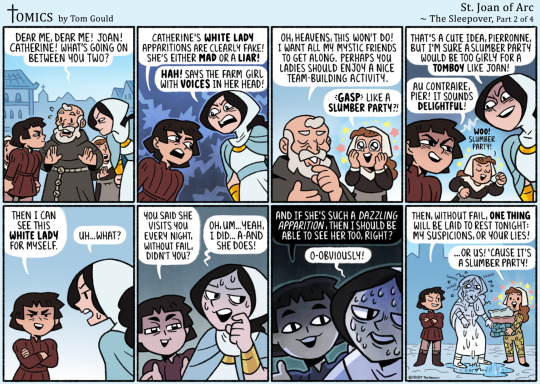
05/24/2024
Continuing from the previous cartoon, St. Joan of Arc plans to out her rival as a fraud... by having a SLEEPOVER?! (Yes, this actually happened in real life.)
___
JOKE-OGRAPHY: 1. The Source: This cartoon is based off of characters and events mentioned in St. Joan of Arc's trial. Here are the relevant passages (translated by W. S. Scott): "Asked what [Catherine] said to her, [Jeanne] answered that this Catherine said [...] that a woman appeared [to her], a white lady, dressed in cloth of gold [...]. [Jeanne] asked Catherine if this Lady appeared every night; and if so, she would sleep with her. And she did so..." 2. Explanation: When asked about Catherine de La Rochelle during her trial, Joan is very curt. When her assessors press for details, Joan eventually shares more. Catherine apparently claimed that an apparition came to her each night -- the White Lady -- and gave her counsel like Joan's Voices. Joan was ironically skeptical, and asked Catherine if the White Lady appeared every night. When Catherine said yes, Joan asked to sleep over to see the Lady for herself. Strangely, Catherine obliged.3. Pierronne the Breton: Besides Joan and Catherine, Brother Richard's club of mystics also included two Breton women -- one named Pierronne, and another who remains unnamed (to my knowledge). Even after all my studying of Joan's life story, I still only just learned about these Breton mystics a couple weeks ago, and I'm already scheming toward including their harrowing fate in a future May of the Maid / June of Arc. 4. Historical / Fiction: The story of Joan sleeping over at Catherine's is historical fact, based on Joan's own words, which I find absolutely hilarious in and of itself. Exactly what led up to this sleepover, however, is only communicated in minimal detail, so I'm filling in some details before getting into the sleepover itself in the next cartoons. I may even redo this story arc someday and tell it in a totally different way, while still being just as historically accurate. In this cartoon, I had Pierronne suggest the sleepover initially, so that I could use another historical character to offset the tension between Joan and Catherine. We'll see how that plays out as the sleepover commences in the next comic!
#catholic#christian#comic#cartoon#catholic memes#christian memes#tomics#bible#tom gould#tomics comics#st joan of arc#joan of arc#jeanne darc#st jeanne darc#catherine de la rochelle#pierronne the breton#pierronne#pierogi#catherine#catherine de la FRAUD#sleepover#slumber party#jamming in jammies#brother richard#white lady#the white lady#can we get some karen jokes in the comments
245 notes
·
View notes
Text

Bordeaux
Bordeaux est une ville pleine de charme. Essentiellement connue pour ses environs viticoles, ses ruelles de pierre, ses restaurants gourmands et ses musées artistiques sont tout autant de raisons de venir la visiter.

Comment venir ?
Bordeaux se situe :
en train : 1h50 de Poitiers, 2h10 de Paris ou de Toulouse, 2h30 de La Rochelle
en voiture : 1h50 de La Rochelle, 2h20 de Toulouse ou Poitiers, 2h30 de Biarritz
en bus : 2h40 de Biarritz, 2h50 de La Rochelle ou de Toulouse

Quand et combien de temps ?
Il est possible de visiter les principales attractions culturelles de Bordeaux en un week-end. On peut ensuite prolonger ces deux jours par un troisième au bord de l'océan ou dans les terres.

Que voir à Bordeaux ?
Des monuments et sites historiques : Darwin, tour Pey Berland, Porte Cailhau, Palais Rohan, grosse cloche, grand théâtre, place de la victoire, place de la bourse, opéra national, quartier Saint Pierre, quai des Marques, rue Sainte Catherine, place des Quinconces, fontaine des Girondins
Du patrimoine religieux : grande synagogue, basilique Saint Seurin, cathédrale Saint André
Des musées : Cité du vin, bassins des lumières, musée d’aquitaine, Méca, musée de la marine, musée des Arts décoratifs et du Design, musée national des Douanes, CAPC, muséum d’histoire naturelle, musée des beaux arts, musée Cap Science, centre Jean Moulin
Des parcs et jardins : jardin public, jardin botanique, parc Bordelais, parc Bourran, parc Rivière, parc de l’Ermitage

Que voir dans les environs ?
Des villes et villages : Arcachon, Toulouse, Royan, Angoulême, Saint Emilion, Blaye, Lacanau, Carcans Maubuisson, Hourtin
Des espaces naturels : dune du Pilat, bassin d'Arcachon
Des lieux historiques : cloître des Cordeliers, cos d’Estournel, château Pédesclaux, château La Louvière, château Les Carmes Haut Brion, château Sainte Barbe, château Marquis d’Alesme Becker, château du Grand Mouëys

crédits photos @lilstjarna
1 note
·
View note
Text
JEANNE D’ALBRET // QUEEN OF NAVARRE
“She was Queen of Navarre from 1555 to 1572. When her father died in 1555, Jeanne and Antoine ascended the Navarrese throne. They reigned as joint rulers until Antoine died from battle wounds in 1562. Jeanne was the acknowledged spiritual and political leader of the French Huguenot movement, and a key figure in the French Wars of Religion. After her public conversion to Calvinism in 1560, she joined the Huguenot side. During the first and second war she remained relatively neutral, but in the third war she fled to La Rochelle, becoming the de facto leader of the Huguenot-controlled city. After negotiating a peace treaty with the French queen mother Catherine de' Medici and arranging the marriage of her son, Henry, to Catherine's daughter Marguerite, Jeanne died suddenly in Paris. Her son succeeded her as Henry III and later became the first Bourbon king of France as Henry IV.”


0 notes
Text
Rencontre avec Catherine Benguigui
Rencontre avec Catherine Benguigui
Après avoir enseigné la danse à l’université, Catherine Benguigui a été à l’origine des services culturels de l’université Lille 2 et de l’université de La Rochelle. Elle est aujourd’hui adjointe à la culture de la ville de La Rochelle et a rejoint en 2023 le Centre national de la musique en tant qu’administratrice représentant les collectivités territoriales. Une belle rencontre de Marguerite La…

View On WordPress
0 notes
Text
Jour 02.
Catherine de Parthenay.
Catherine de Parthenay est une des figures du protestantisme du XVI et XVIIe. Elle perd d'ailleurs son premier mari lord de la Saint-Barthelemy (d'ailleurs un processus d'annulation du mariage etait lancé).
Elle épouse en second noce René II de Rohan. Elle sera la mère des Rohan, chefs des protestants.
Elle donna une très bonne éducation à ses enfants.
Elle aimait les chats 💚.
En 1627, elle s'enferme à La Rochelle avec sa fille lors du siège mené par Louis XIII et Richelieu. Jusqueboutiste, elle sera l'une des rares personnes emprisonnées - n'ayant pas jouie du pardon général - sur ordre de Richelieu. Le puissant Cardinal espérait aussi avoir un moyen de pression sur ses fils.
instagram
0 notes
Text

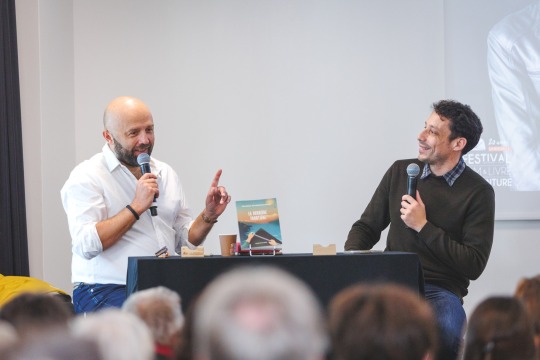

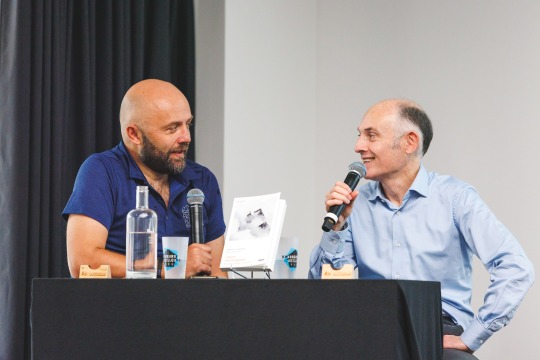



📌 [BILLET] Confidences, réflexions, amitié, générosité, nature, littérature... Au récent Festival Int. du Film et du Livre d'Aventure de La Rochelle (qui fêtait cette année ses 20 ans), j'ai vécu l'aventure "in vivo" et "in palpu".
📽️🎵 Si la majorité du public s'est précipitée regarder des films sur grand écran (et c'est tant mieux !), une minorité s'est également rendue 🎪🏕️ salle Eider pour voir et écouter des auteurs et/ou des dessinateurs nous raconter leurs œuvres et leurs coulisses.
❤️🔥 J'ai mis du cœur, des émotions, de la passion et de la fougue pour animer et modérer ces débats, histoire de faire vivre la #littérature d'aventure.
🎯 Merci encore aux organisateurs - Stephane Fremond et sa complice Anne Buisson - d'avoir pensé à moi pour cette mission "caméléon" que j'ai adorée.
🎙 🙏 Remerciements chaleureux à mes invités que j'ai interrogés sur scène : Cédric Gras, Wilfried N'Sondé, David Chambre, Ghislain BARDOUT, Volodia Petropavlovsky, François-Xavier de Crécy, Maylis Adhémar, Virginie Troussier, Florent Silloray, Fabrice Lardreau, Baloup Clément, PIERRE EMMANUEL DEQUEST, Dussey Flore, Caroline Riegel, Virgile Dureuil, Jeanne Mascolo de Fillipis, Abolivier Gwenaëlle, Laurent Tillon et Joël Auvin dit Nono.
🙌 Salutations également à tous ceux que j'ai croisés sur ma route (comme sur la piste🕺) durant ces 5 jours dont Nathalie Verlinden, Catherine Destivelle, Emmanuelle Périé-Bardout, Parent Isabelle, Coralie Jugan, Marion Martineau Charlot, Sophie Planque - Cierpka et Jérémy, luc MARESCOT, Evrard Wendenbaum, Thomas Firh, Nicolas Alberty, Vincent Le Goff et tous ceux que j'oublie.
🎚️ Clins d’œil à l'équipe technique Jerome Pougnant et Thomas Videcoq car oui le son c'est bon !
🌊 Pensées affectueuses au capitaine de frégate littéraire Fabien Clauw.
📸 @h.lafitte
#fifav#édition2023#festival#film#livre#aventure#la rochelle#animation#débat#littéraire#littérature#voyage
1 note
·
View note
Text


(…) Joan, too, played her part in elaborating the symbols of what the poet called the ‘maidenly war’ that she was about to undertake. She asked the king to send to the town of Sainte-Catherine-de-Fierbois, where she had stayed on her way from Vaucouleurs, to fetch a sword that, she said, lay hidden in the church there. Sure enough, and to general amazement, the weapon was discovered – according to the clerk at La Rochelle, inside a coffer at the high altar that had not been opened for twenty years. Christian warriors, contemporaries knew, carried holy swords, from King Arthur’s Excalibur to Charlemagne’s Joyeuse, and wise heads nodded at the thought that Joan’s should come to her from St Catherine, the patron of young virgins, who was so often depicted carrying the sword through which she had met her martyrdom.
Joan of arc: a History by Helen castor.
#joan of arc#jeanne d’arc#saint joan of arc#art#history#women in history#15th century#french history#jeanne d'arc#saint joan#helen castor
161 notes
·
View notes
Photo
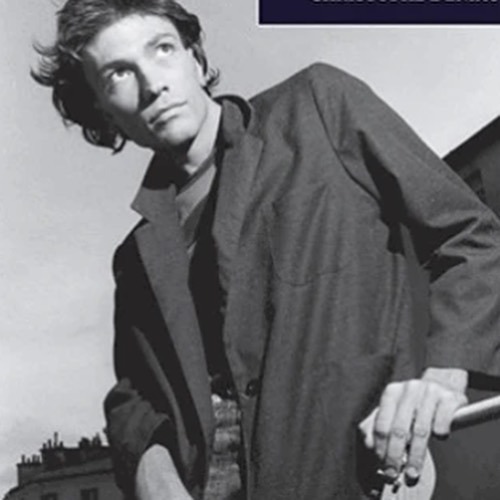
Daniel Darc, dandy sombre et lumineux ! "Mannequin" et surtout "cherchez le garçon" premier hymne du rock français des 80s apportent la reconnaissance du public et surtout ouvre les portes des émissions TV à Taxi Girl, groupe formé par une bande de potes de lycée ! Avec ses allures de poète maudit et sa gueule d'ange, qui aurait rencontré le rock'n'roll et le punk, Daniel Darc (Dark?) semble flotter au milieu du groupe qui vit ses premiers succès et ses derniers moments. À l'époque son manager fait courir le bruit qu'il est le fils de Catherine Deneuve. Il fait ses premières télés, en chemise rouge, en débardeur gris ou en t-shirt noir mais toujours en jean. Il restera fidèle toute sa vie aux pièces iconiques du Rock : le blouson de cuir, la veste en jean (parfois portée sous une veste) les bottes de motard, les bras tatoués, les bagues et les oreilles percées. Longtemps considéré comme un pestiféré il revient après dix ans d'absence et de dérives avec Crève Coeur. L'album, l'un des meilleurs de cette année-là, lui vaut à 45 ans une Victoire de la musique. Croix tatoué sur la poitrine, d’origine juive, il se convertit au protestantisme. Dieu l'a sauvé, il ne s'en cache pas. Il chante le psaume 23 sur scène, la bible sur le coeur. "Je suis un croyant qui doute" aime-t-il à répéter. Fasciné par la rédemption, Huysmans, Drieu La Rochelle, Jacques Rigot, Rebatet, Céline, ou encore Jean Genet sont ses auteurs favoris. Daniel est convaincu que "Le christianisme et le rock n roll sont les dernières formes d'honnêteté.". Il meurt en 2013. "Quand je mourrai, j'irai au paradis/C'est en enfer que j'ai passé ma vie", chantait Daniel Darc, en 2008, dans l'album Amours suprêmes. #daniellevychemisier #danieldarc #icone #àlafrançaise Merci @ze_french_do_it_better pour ce texte. (à Daniel Lévy) https://www.instagram.com/p/CVQkpdLMSbF/?utm_medium=tumblr
1 note
·
View note
Photo




Charles Baziray (b.1685 - d.1755), 'Portrait of the Comtesse de Gennes', oil on canvas, c.1747, French, sold by Olivier d'Ythurbide Antiques; Paris, France.
Little is known about Charles Baziray, but he may have been a pupil of Nicolas de Largilliere, and his works are found in many noble collections of Nantes, Rennes, Fougeres and Saint Malo. (x)
The identity of the sitter is unclear as the title of ‘Comte and Comtesse de Gennes’ is difficult to trace online. She may be one of the wives or daughters of Jean Baptiste de Gennes, Comte d’Oyac* b.1656 - d.1705), who married two women: Marie Guillet (m. 1681), with whom some sources say they had 5 daughters (and perhaps a son); then later Marie Savouret (m. 1690), with whom he had three daughters and a son, Jean Guillaume de Gennes (b. 1699 - d. 1787), Comte de Gennes and Archdeacon of La Rochelle.
As a priest, Jean Guillaume died childless, with his title passing to his niece Marie Genevieve de Gennes (b.1755 - d.1838), who was the daughter of Marie Catherine Gaultier (b.1721 - d.1776), who in turn was daughter of Jean Baptiste with Marie Savouret. Marie Genevieve was appointed ‘Countess of Gennes in 1787 on the death of her priest uncle, the letters patent of 1698 relating to the erection of land in Guyana under the name of Gennes for the benefit of "heirs and successors both male and female"’ (x).
*while I found reference to Jean Baptiste primarily as ‘Comte d’Oyac, I also found reference to him as a Comte de Gennes. Presumably he was entitled to both, as his son inherited the title, followed by his granddaughter, but I could not be certain.
#honestly I have no idea who this might be except maybe marie savouret#but it was fun to research nonetheless#charles baziray#unknown sitter#known artist#french#oil on canvas#1740s#olivier d'ythurbide#paris#nicolas de largilliere#comte de gennes#comtesse de gennes
14 notes
·
View notes
Text
Was Joan of Arc a Lesbian? Yes!
Claims that Joan of Arc was a lesbian typically stem from two sections within the transcripts of her Condemnation Trial and Rehabilitation Trial. In the Condemnation Trial, Joan appears to have taken the initiative in wanting to spend two nights in bed with Catherine de La Rochelle to see the lady-in-white, whom Catherine claimed to appear as an apparition. Testimony during the Rehabilitation Trial by Marguerite la Touroulde indicated the two women shared a bed nearly every day for three weeks. First, a note about the following segment of the Condemnation Trial transcripts of March 3: Joan asked this Catherine if the lady-in-white who appeared to her came every night, saying that she would, to see her, sleep in the same bed with Catherine; and she went to bed with her and stayed up until midnight, but saw nothing, and then went to sleep. In the morning, Joan asked Catherine whether the lady-in-white had come to her. Catherine replied that she had, while Joan was sleeping, but that she had not been able to awaken Joan. Then Joan asked if the lady might not come another night, and Catherine answered yes; so Joan slept during the day, so that she might stay awake the whole night. That night she stayed in the bed with Catherine and watched all night, but saw nothing. Throughout the night Joan often asked Catherine whether the lady-in-white would come, and Catherine answered, “Yes, soon!” The text above is translated as faithfully as possible from the French. For readers comparing this translation to W.P. Barrett’s English translation of 1932, it’s important to note that Barrett’s translation is obfuscated to some degree. For example: Barrett’s translation—and she slept with her, and watched till midnight, saw nothing, and went to sleep. Sanguinetti’s translation—and she went to bed with her and stayed up until midnight, but saw nothing, and then went to sleep. Quicherat’s translation—et y coucha et veilla jusqu'à minuit, et ne vit rien; et puis s’endormit. A second example regarding the use of exclamation marks: Barrett’s translation: “Yes, presently.” Sanguinetti’s translation: “Yes, soon!” Quicherat’s translation: “Oui, bientôt!” These notes are important for some critics because English translations of the source material often muddle or omit text from Quicherat’s source. The following text is from the Rehabilitation Trial transcripts documenting the testimony of Marguerite la Touroulde, widow of Réné de Bouligny, advisor to the king: She was in my house for three weeks, sleeping, eating, and drinking there. And almost every night I slept with Joan, and I never saw or noticed anything uncanny about her. But she behaved and continued to behave like an honest and Christian woman. She confessed very often, gladly heard the Mass, and often asked me to go to Matins; and at her request I did go and took her there several times. (76) Touroulde’s testimony is often used to support claims that Joan was a lesbian, and a disconcerting portion of her testimony is omitted in a popular English translation that is replicated numerous times on the web; the text that is omitted is the following: I saw her several times in the bath and in the hot-room, and so far as I could see I believe that she was a virgin. (76) Latin source text: Dicit insuper quod eam pluries vidit in balneo et stuphis, et, ut percipere potuit, credit ipsam fore virginem. (79) French translation: Elle déclare en outre qu’elle vit plusieurs fois Jeanne au bain et dans les étuves; elle croit, comme elle a pu le constater, qu’elle était vierge. (80) The Latin word stuphis may be translated as “steam bath” or alternately as a geologic thermal spring, such as a source of hot sulfur spring water. For readers interested in the location where the omitted text should appear in Touroulde’s testimony, the following material provides the context, with the omitted text underlined: Jeanne was very liberal in almsgiving, and willingly succored the poor and indigent, saying that she had been sent for their consolation. And I saw her several times in the bath and in the hot-room, and so far as I could see I believe that she was a virgin. I have no doubt that she was virgin. According to my knowledge she was quite innocent, unless it be in warfare. She rode on horseback and handled the lance like the best of the knights, and the soldiers marveled. (81) Joan’s time in bed or in the baths with Marguerite la Touroulde or time in bed with Catherine de La Rochelle doesn’t provide conclusive evidence that Joan was a lesbian primarily because bedding was relatively scarce in the fifteenth century and it was not uncommon for women to share a bed. However, it is reasonable to ask why Touroulde would state, “so far as I could see I believe that she was a virgin.” That, too, isn’t conclusive because testimony from the Rehabilitation Trial revealed that Joan not only was examined on several occasions regarding her virginity, but she sometimes challenged others to inspect her if they didn’t believe it, so she may have offered to “prove” her virginity to Touroulde solely to establish the fact. While individual historical facts are inadequate to make any definitive conclusions about Joan’s sexual orientation, when viewed in their entirety, it is reasonable to make the assertion that Joan was a lesbian, particularly in light of several statements made by Joan, which are assumed to be referring to the apparitions of Saint Catherine and Saint Margaret, but instead could be referring to Catherine de La Rochelle and Marguerite la Touroulde: March 12 Session: We asked whether she spoke to our Lord when she promised Him to keep her virginity, and she answered that it was quite enough to promise her virginity to those who were sent from Him, namely Saint Catherine and Saint Margaret. This statement is problematic because shortly after Joan makes this assertion, she stated, “the first time she heard her Voice she vowed to keep her virginity as long as it would please God, and that she was 13 years old or about 13 years old at the time,” which is prior to the time she reports promising her virginity to Saint Catherine and Saint Margaret. March 17 Session: Asked why she so happily looked at this ring when she was going into battle, she answered that it was out of pleasure and in honor of her father and mother, and because, having her ring on her finger and in her hand, she touched Saint Catherine who appeared before her. Asked what part of Saint Catherine she had touched, she said, “You will get no answer from me.” Asked if she had ever kissed or touched Saint Catherine or Saint Margaret, she answered she had touched them both. We asked if Saint Catherine or Saint Margaret had a fine fragrance and she answered that it is good to know that they did. Asked whether, when embracing Saint Catherine or Saint Margaret, she felt heat or anything else, she said that she could not embrace them with-out feeling and touching them. Also, Article 1 submitted to the assessors on April 5 included the following: Moreover, the so-called Saint Catherine and Saint Margaret instructed Joan, in the name of God, to take and wear men’s clothes; and Joan has worn them, and still wears them, stubbornly obeying this command to such an extent that Joan has declared that she would rather die than abandon wearing these clothes. View my book on Amazon: https://www.amazon.com/dp/B01CGVYWJU
19 notes
·
View notes
Text

05/20/2024
"May of the Maid" continues with a story-arc featuring Joan's real-life rival mystic?!
___
JOKE-OGRAPHY:
1. The Source: This cartoon is based off people who are mentioned briefly in St. Joan of Arc's trial. Here are some relevant passages (translated by W. S. Scott):
1a. Extorting Peasants / Housewifery: "This Catherine said [...] that a woman appeared, a white lady, dressed in cloth of gold, who told her to go through the good towns, and that the king would give her heralds and trumpets to proclaim that whoever had gold, silver, or treasure should at once bring it forth; and that she would know those who did not and those who had hidden it; and would know where to find the treasure; and it would serve to pay Jeanne's men-at-arms. To which [Jeanne] had answered that [Catherine] should return to her husband, and look after her household and children."
1b. Too Chilly: "Asked if she had spoken to Catherine de la Rochelle concerning going to La Charité, [Jeanne] replied that Catherine did not advise her to go there; saying that it was too cold, and she ought not to go."
1c. Premature Truce: "[Jeanne] said also to Catherine, who wished to go to the Duke of Burgundy to make peace, that it was her opinion that they would find no peace save at the lance's point."
2. The Characters: Brother Richard was a Franciscan friar and a doomsday preacher. In 1429, he was prophesying the end times in 1430. He was incorrect, but before people knew that, his sermons stirred whole cities. He also seemed to try and befriend any female mystics (women with visions) he came across, probably to boost his legitimacy. Catherine de La Rochelle was one of these mystics. She and Joan might've started out as friends, but Joan eventually came to suspect Catherine of being a fraud and told the king so. As you might guess, that didn't go over well with Brother Richard or Catherine. It might be because their relationship ended on a sour note that Joan is so short in her answers to questions about them during her trial.
#catholic#christian#comic#cartoon#catholic memes#christian memes#tomics#tomics comics#tom gould#joan of arc#st joan of arc#jeanne darc#st jeanne darc#brother richard#catherine de la rochelle#sleepover#why is it called sleepover you ask#find out next time on#MAY OF THE MAID
342 notes
·
View notes
Photo

📚 2023 Book Releases, Part II Here is part II of the book releases I'm looking forward to, which includes what I see as Law & Order: SVU meets The Fifth Element. ▫️Encore in Death, J. D. Robb ▫️Secretly Yours, Tessa Bailey ▫️Seven Faceless Saints, M. K. Lobb ▫️Tethered, Elayna R. Gallea ▫️Ruby Spencer‘s Whiskey Year, Rochelle Bilow ▫️The Neighbor Favor, Kristina Forest ▫️Flowerheart, Catherine Bakewell ▫️The Witch and the Vampire, Francesca Flores ▫️Ana María and The Fox, Liana De la Rosa
#bookstagram#book#read#booklover#bookworm#booknerd#bookaddict#reading#bibliophile#bookrelease#tbr#bookish#books#booklove#booklife#bookreader#lit#bookannouncement#bookishnews#newbook#fiction#encoreindeath#secretlyyours#sevenfacelesssaints#tethered#rubyspencerswhiskeyyear#theneighborfavor#flowerheart#thewiitchandthevampire#anamariaandthefox
1 note
·
View note
Text
Opera Simplified #7: Les Huguenots—Before You Go, Some Geographical and Historical Context:
AKA What You Need To Know About The French Wars of Religion:
-If you know anything about 16th century Europe, it’s that the girls (Catholics and Protestants) were FIGHTINGGGG.
-France was no exception.
-Protestantism found its way to France in the 1520s and quickly became popular among nobles, merchants, and ordinary folks alike for various reasons that I will not get into right now because I’m trying to keep this short and also it’s 2 AM when I’m writing this.
-By the time the opera takes place, about 10% of the French population was Protestant, the vast majority of them Calvinists.
-the French Protestants were given the collective nickname Huguenots. Thus the title of the opera.
-anyway-
-Following the sudden death of Henri II de Valois, King of France, in 1559, a series of power struggles began over the royalty and court influence, especially given that increasing numbers of nobles were converting to Protestantism. in 1561, the government passed the Edict of Saint-Germain, which gave Protestants limited freedom of worship in the hopes that there wouldn’t be a civil war.
-but on March 1, 1562, a group of Catholic soldiers murdered about 50 Huguenots attending a church service. this was called the Massacre of Vassy, and oopsie! it started a civil war.
-the first war ended about a year later with the Edict of Amboise. uneasy peace followed.
-in 1567, a bunch of Huguenot nobles decided to overthrow and kidnap King Charles IX in what was called the Surprise of Meaux. however this failed spectacularly and it started a second civil war, which ended the following year with the Edict of Longjumeau (presumably no relation other than place name to Adolphe Adam’s 1836 opera Le postillon de Lonjumeau), which was basically “meh let’s do what the Edict of Amboise did”.
-and then they started a third civil war in 1569 like a bunch of dumbasses
-and then it was ended in 1570 by the Peace of Saint-Germain-en-Laye.
-so for the last two years before the beginning of the opera, there has been yet another more or less uneasy peace.
-here is a map of France at about the time the opera takes place. the province of Touraine (where the first two acts are set) is approximately circled in blue. the little dot with an arrow pointing to it is the approximate location of the Huguenot city of La Rochelle, which is not home to any of the opera’s action but is nevertheless an important city:

-meanwhile, in an effort to reconcile the religious factions, Queen Mother Catherine de Médicis (Caterina de Medici), Henri II de Valois’ widow and King Charles IX’s mother, announced in 1572 that she would be marrying off her 19-year-old daughter Marguérite de Valois to the Huguenot King of Navarre Henri de Bourbon. The wedding was set to be held in Paris on August 18th.
-and btw, if you’re wondering “wait, is Marguérite de Valois related to Élisabeth de Valois? like the one from Don Carlos?” the answer is yes (they were sisters).
-and that’s what you missed on the French Wars of Religion!
#opera#opera tag#les huguenots#notes#background context#meyerbeer#giacomo meyerbeer#french wars of religion#augustin eugène scribe#émile de saint-amand deschamps
1 note
·
View note
Photo



«GIUDICE: Hai conosciuto Catherine de la Rochelle? L’hai incontrata? GIOVANNA: Sì, a Jargeau e a Montfaucon nel Berry. GIUDICE: Non ti mostrò una dama vestita di bianco che, a suo dire, andava spesso a trovarla? GIOVANNA: No. GIUDICE: Che cosa ti ha raccontato? GIOVANNA: Che andava a trovarla una dama bianca, vestita di broccato di oro fino; che questa dama le diceva di farsi dare dal re degli araldi e dei trombettieri e di andare di città in città a proclamare che chiunque possedesse oro, argento o tesori nascosti li consegnasse subito. Diceva che avrebbe saputo riconoscere quelli che non ubbidivano e che avrebbe scovato i loro tesori nascosti. «Mi serviranno a pagare i miei soldati», diceva. Io le risposi di tornare da suo marito, di badare alla casa e di accudire i suoi bambini. Poi per essere ben sicura ne parlai a santa Margherita e a santa Caterina le quali mi dissero che tutta la faccenda di questa Catherine era pura follia! Scrissi al re che gliene avrei parlato e quando lo vidi di persona gli dissi che la storia di quella Catherine era tutta una follia, una cosa senza fondamento. Solo che frate Richard voleva che la si lasciasse fare. Furono molto in collera con me, frate Richard e quella Catherine! GIUDICE: Hai parlato a Catherine de la Rochelle del piano di battaglia della Charité? GIOVANNA: Catherine mi disse di non andarci, che faceva troppo freddo e che lei non ci sarebbe andata. Lei voleva andare dal duca di Borgogna per chiedergli di fare la pace; io le dissi che secondo me non avremmo trovato la pace se non sulla punta delle nostre spade. [...]» [cit. Cremisi Teresa, Il Processo di Condanna di Giovanna D’Arco, SE srl, Milano 2000, pp. 68 - 70.] ⚔️ Here is a silkscreen print from the book Relapsa and another picture of the local group exhibition Artifici.o 🌻 For prices informations on the available prints, DM me or contact me by e-mail: [email protected]
https://www.instagram.com/p/CfExOYKMQLL/?utm_source=ig_web_copy_link
#Illustration#silkscreenprinting#joan of arc#relapsa#teresacremisi#book project#editorialillustration#handboundbook#artexhibition#groupexhibition
0 notes
Text
Rencontre avec Catherine Lam
Ancienne résidente de l’Atelier Bletterie, Catherine Lam est installée depuis 2018 dans L’Atelier des Roseaux qu’elle a fondé dans le quartier de Fétilly à La Rochelle. Elle s’y consacre à la céramique tournée et modelée. Une belle rencontre de Marguerite La Rochelaise lors de sa récente exposition à l’Atelier Bletterie. Catherine Lam en trois mots ? Eurasienne, enseignante, artiste. Ton plus…

View On WordPress
#art#artiste#arts visuels#belles rencontres#catherine lam#clin d&039;art#créateur#La Rochelle#marguerite la rochelaise#sculpture
0 notes
Video
youtube
Saint of the Day – 28 April – St Louis Marie Grignion de Montfort (1673-1716) Priest, Founder, Confessor, Writer, Poet, Apostle of the Holy Eucharist and Adoration, Apostle of the Blessed Virgin Mary, Apostle of the Holy Rosary, Preacher, Missionary Apostolic. St Louis was born on 31 January 1673 at Montfort-La-Cane, Brittany, France – he Died on 28 April 1716 at Saint-Laurent-sur-Sovre, France of natural causes. He was Canonised on 20 July 1947 by Pope Pius XII. Patronages: preachers, Brothers of Saint Gabriel, Company of Mary, Daughters of Divine Wisdom.
St Louis was known in his time as a preacher and was made a missionary apostolic by Pope Clement XI. As well as preaching, he found time to write a number of books which went on to become classic Catholic titles and influenced several popes. He is particularly renowned for his great devotion to the Blessed Virgin Mary and the practice of praying the Rosary. He is considered as one of the forerunner writers in the field of Mariology. His most notable works regarding Marian devotions are contained in The Secret of Mary and the True Devotion to Mary. A “founders statue” created by Giacomo Parisini is located in an upper niche of the south nave of Saint Peter’s Basilica.
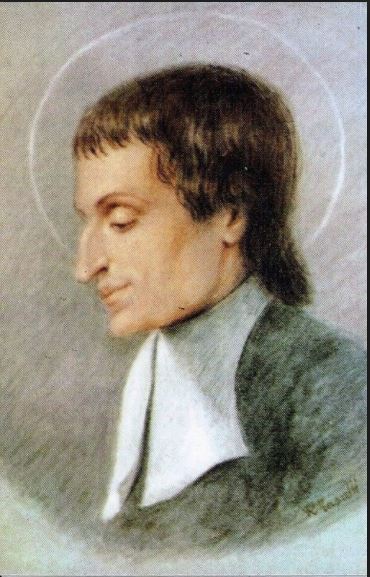
Today the universal Church celebrates the feast day of Louis-Marie de Monfort, a 17th century saint who is revered for his intense devotion to the Blessed Virgin Mary.
St Louis Marie is perhaps most famously known for his prayer of entrustment to Our Lady, “Totus Tuus ego sum,” which means, “I am all yours.” The St Pope John Paul II took the phrase “Totus Tuus” as his episcopal motto.
Born in Montfort, Brittany, on 31 January 1673, St Louis Marie possessed a strong devotion to the Blessed Sacrament as a child and was also intimately devoted to the Blessed Virgin, especially through the Rosary. He took the name Marie at his confirmation.
He was ordained a priest in June 1700 and assigned to Nantes. His great desire was to go to the foreign missions, preferably to the new French colony of Canada but his spiritual director advised against it. His letters of this period show that he felt frustrated from the lack of opportunity to preach as he felt he was called to do.
In November 1700 he joined the Third Order of the Dominicans and asked permission not only to preach the rosary but also to form rosary confraternities. He began to consider the formation of a small company of priests to preach missions and retreats under the standard and protection of the Blessed Virgin. This eventually led to the formation of the Company of Mary. At around this time, he first met Blessed Marie Louise Trichet (1684-1759) when he was appointed the chaplain of the hospital of Poitiers. That meeting became the beginning of Blessed Marie Louise’s thirty-four years of service to the poor.
He set off to make a pilgrimage to Rome, to ask Pope Clement XI, what he should do. The Pope recognised his real vocation and, telling him that there was plenty of scope for its exercise in France, sent him back with the title of Apostolic Missionary. On his return from his long pilgrimage to Rome, Montfort made a retreat at Mont Saint Michel “to pray to this archangel to obtain from him the grace to win souls for God, to confirm those already in God’s grace, and to fight Satan and sin”. These occasions gave him time to think, contemplate and write.

For several years he preached in missions from Brittany to Nantes. As his reputation as a missioner grew, he became known as “the good Father from Montfort”.
He left Nantes and the next several years were extraordinarily busy for him. He was constantly occupied in preaching missions, always walking between one and another. Yet he found time also to write – his True Devotion to Mary, The Secret of Mary and the Secret of the Rosary, rules for the Company of Mary and the Daughters of Wisdom and many Hymns. His missions made a great impact, especially in the Vendée. The heated style of his preaching was regarded by some people as somewhat strange and he was poisoned once. Although it did not prove fatal, it caused his health to deteriorate. Yet he continued, undeterred. He went on preaching and established free schools for the poor boys and girls.
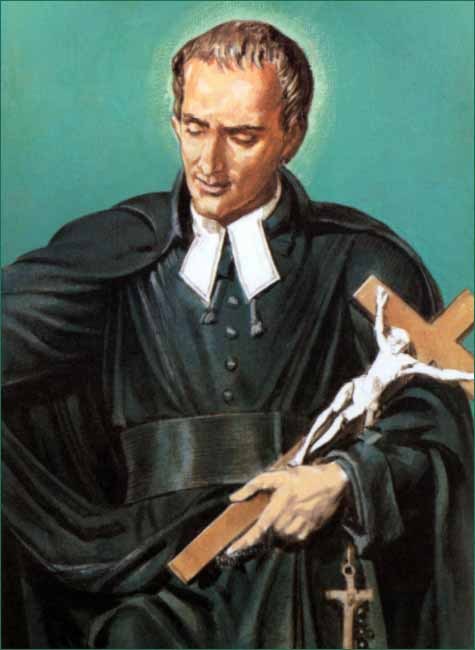
Daughters of Wisdom The bishop of La Rochelle had been impressed with Montfort for some time and invited him to open a school there. Montfort enlisted the help of his follower Marie Louise Trichet who was then running the General Hospital in Poitiers. In 1715 Marie Louise and Catherine Brunet left Poitiers for La Rochelle to open the school there and in a short time it had 400 students. On 22 August 1715, Trichet and Brunet, along with Marie Valleau and Marie Régnier from La Rochelle received the approbation of Bishop de Champflour of La Rochelle to make their religious profession under the direction of Montfort. At the ceremony Montfort told them: “Call yourselves the Daughters of Wisdom for the teaching of children and the care of the poor.” The Daughters of Wisdom grew into an international Order and the placing of Montfort’s founders statue in Saint Peter’s Basilica was based on that Order.


Death and burial Worn out by hard work and sickness, he finally came in April 1716 to Saint-Laurent-sur-Sèvre to begin the mission which was to be his last. During it, he fell ill and died on 28 April of that year. He was 43 years old and had been a priest for only 16 years. His last sermon was on the tenderness of Jesus and the Incarnate Wisdom of the Father. Thousands gathered for his burial in the parish church and very quickly there were stories of miracles performed at his tomb. Exactly 43 years later, on 28 April 1759, Marie Louise Trichet also died in Saint-Laurent-sur-Sèvre and was buried next to Montfort. On 19 September 1996, St Pope John Paul II (who beatified Trichet) came to the same site to meditate and pray at their adjacent tombs.

Spirituality “God Alone”: was the motto of Saint Louis and is repeated over 150 times in his writings. The Incarnation: “The Incarnation of the Word is for him the absolute central reality.” Love of the Blessed Virgin Mary Fidelity to the Cross Missionary Zeal

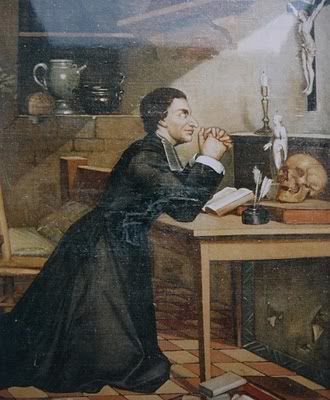
Total Consecration to Mary In Montfort’s approach to Marian consecration, Jesus and Mary are inseparable. He views “consecration to Jesus in Mary” as a special path to being conformed to, united and consecrated to Christ, given that:
” …of all creatures the one most conformed to Jesus Christ, it follows that among all devotions that which most consecrates and conforms a soul to our Lord is devotion to Mary, His Holy Mother and that the more a soul is consecrated to her, the more will it be consecrated to Jesus Christ.” “God the Father made an assemblage of all the waters and He named it the sea. He has made an assemblage of all His graces and He has called it Mary.”
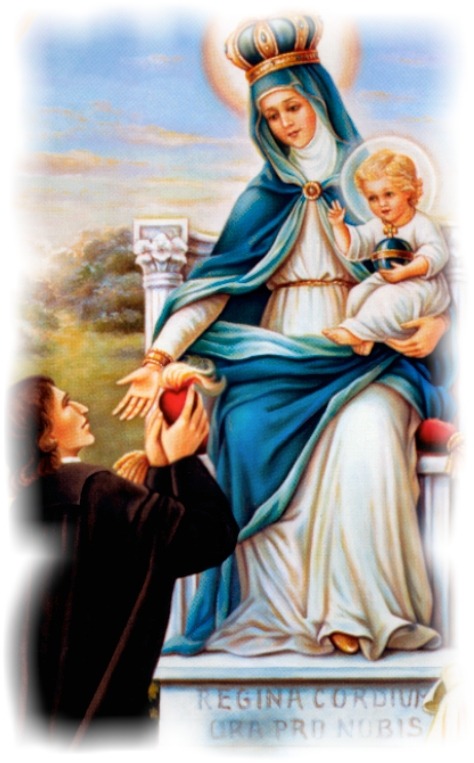
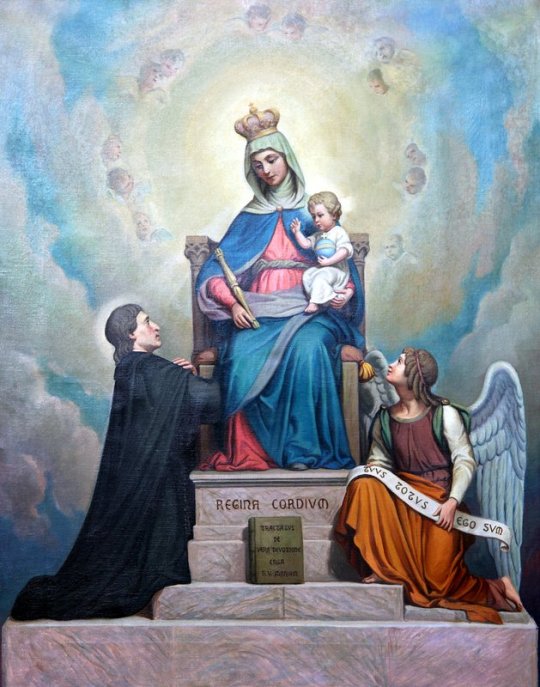
Louis de Montfort influenced a number of popes In the 19th century, Pope Pius IX considered it the best and most acceptable form of Marian devotion, while Pope Leo XIII granted indulgences for practicing Montfort’s method of Marian consecration. Leo beatified Montfort in 1888, selecting for Montfort’s beatification the day of his own Golden Jubilee as a priest. In the 20th century St Pope Pius X acknowledged the influence of Montfort’s writings in the composition of his encyclical Ad diem illum. Pope Pius XI stated that he had practised Montfort’s devotional methods since his early youth. Pope Pius XII declared Montfort a saint and stated that Montfort is the guide “who leads you to Mary and from Mary to Jesus.” St Pope John Paul II once recalled how as a young seminarian he “read and reread many times and with great spiritual profit” a work of de Montfort and that: “Then I understood that I could not exclude the Lord’s Mother from my life without neglecting the will of God-Trinity.” According to his Apostolic Letter Rosarium Virginis Mariae, the pontiff’s personal motto was “Totus Tuus.” The thoughts, writings, and example of St Louis de Montfort were also singled out by St Pope John Paul II’s encyclical Redemptoris Materas a distinctive witness of Marian spirituality in the Roman Catholic tradition
While the saint is best known for his spiritual writings, he was also a poet and during his missions managed to compose more than 20,000 verses of hymns. Montfort’s hymns and canticles were, for the most part, meant to be sung in village churches and in the homes of the poor. Some authors argue that a reading of Saint Louis’s hymns is essential for an understanding of him as a man and for appreciating his approach to spirituality. He is also said to have carved at least three statues depicting the Madonna and Child.
St Louis Marie Grignion de Montfort, Pray for us!
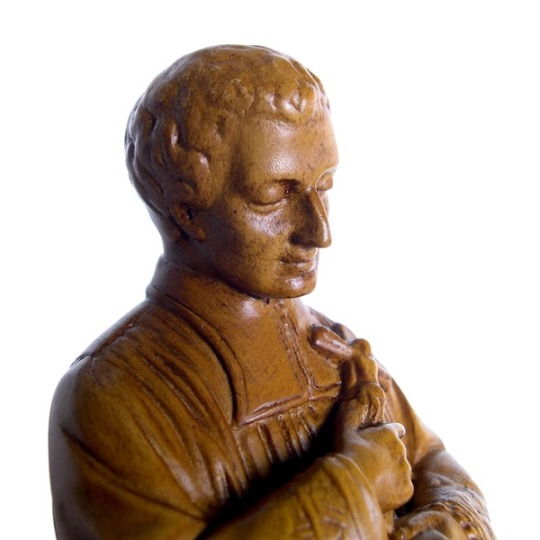

(via Memorials of the Saints - 28 April)
10 notes
·
View notes